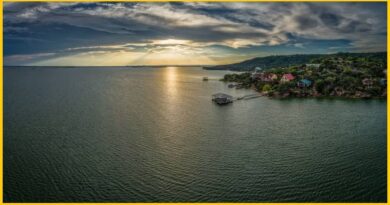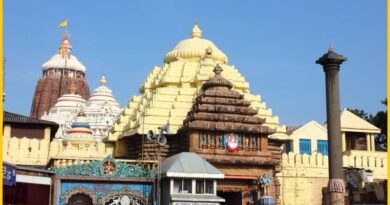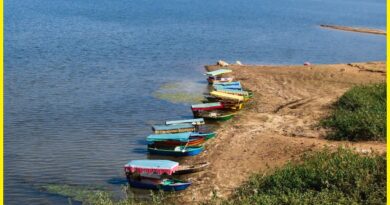Umananda Island
Umananda Island is the smallest inhabited river islet on the Brahmaputra River, flowing through the city of Guwahati in Assam, a state in northeast India. It holds cultural, historical, and natural significance, making it a popular destination for both tourists and pilgrims. Its name derives from Assamese Uma, another name for the Hindu goddess Parvati, the wife of Shiva. A British officer named the island Peacock Island for its structure, which he thought resembled the splayed feathers of a peacock. The island is surrounded by lush greenery and offers scenic views of the Brahmaputra River. It’s a peaceful retreat away from the hustle and bustle of the city.
Mythological Tails
The place is also known as Bhasmachal, from the words bhasma, meaning ‘to destroy’, and chal, meaning ‘place’. It is said that Lord Shiva meditated at this hillock, and once during his meditation, Kamadeva interrupted him because of which Lord Shiva became very angry and opened his third eye and burned Kamadeva to ashes. Due to this particular event, this place is also known as the Bashmacala. Other than its history this island is verdant green and has many different birds, plants, and animals, residing on it.
Umananda Mandir is situated on this island. The temple on this island is dedicated to Lord Shiva and was built in 1694CE under the patronage of King Gadhadhar Singha.
Geology of Umananda Island
Umananda Island, like many other islands in river systems, is likely formed by the deposition of sediment carried by the Brahmaputra River. The island’s geological history is closely tied to the dynamics of river sedimentation and erosional processes in the region.

The Brahmaputra River, one of the major rivers in the world, has a complex network of channels and islands. River islands are often dynamic landforms influenced by sediment transport, erosion, and deposition. The geology of Umananda Island is shaped by the ongoing interaction between the river and the land.
The broader geological setting of the region is influenced by tectonic processes. The Indian subcontinent is converging with the Eurasian plate, leading to tectonic activity in the Himalayan region. While Umananda Island itself is not directly situated in the Himalayas, the regional tectonic context plays a role in shaping the landforms and geological features.
Also read- Assam’s Deepor Beel- A Haven for Wildlife and Wetland Enthusiasts
Umananda Island History
The island’s history dates back to the Ahom Kingdom, which ruled the region for several centuries. The Ahom kings played a significant role in shaping the cultural and architectural landscape of Assam.
Umananda Temple, dedicated to Lord Shiva, is the primary historical and religious structure on the island. It is believed that the temple was built in the 17th century by King Gadadhar Singh, a ruler of the Ahom dynasty. The king constructed the temple in reverence to Lord Shiva, and it stands as a symbol of devotion and faith.
The British occupation of Assam in the 19th century had an impact on the island. The British colonial rulers recognized its strategic location and maintained control over the region.
Umananda Island Map
Umananda Devaloi is a Shiva temple located at Umananda Island in the middle of the river Brahmaputra. See the detailed in the route map.

Umananda Island Ropeway
There is a ropeway directly connecting Guwahati to Umananda Island. Guwahati Ropeway is India’s first river ropeway spanning a distance of about 1.8 km from the bank of Guwahati city to North Guwahati bank. From the ropeway, one can experience the mesmerizing view of the mighty Brahmaputra river, an aerial view of Umananda Island, and the panoramic view of Guwahati city and its surroundings. Visitors also take ferries or motorboats from the Kachari Ghat or Sukreswar Ghat in Guwahati to reach the island. The ropeway projects or changes in transportation options to Umananda make it easier to travel.
Peacock Island Wildlife Sanctuary
Umananda is part of the Peacock Island Wildlife Sanctuary, known for its rich biodiversity. The sanctuary is home to various species of flora and fauna, and visitors can enjoy bird watching. Many tour operators offer river cruises that include a visit to Umananda Island. These cruises provide a unique perspective of the Brahmaputra River and its surroundings.
The Island is a blend of cultural, religious, and natural attractions, making it a well-rounded destination for those visiting Guwahati and seeking a serene escape with historical and spiritual significance.

How to reach Umananda Island
The most common way to reach Umananda Island is by taking a ferry or motorboat from either Kachari Ghat or Sukreswar Ghat in Guwahati. These are the main departure points for boat rides to the island. The boat ride provides scenic views of the Brahmaputra River.
Regular boat services operate from these ghats to Umananda Island. The boat journey is relatively short, and you can enjoy the river’s beauty during the ride. Kachari Ghat is a popular starting point for boat rides to Umananda. It is located near the Fancy Bazaar area in Guwahati.
Post Views: 1,358






